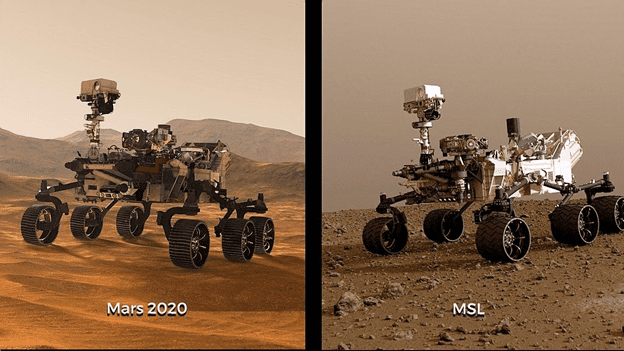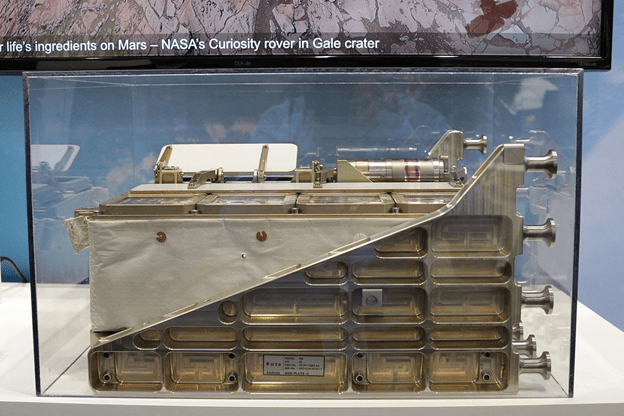At the Kennedy Space Center, NASA is finalizing preparations to launch the Mars 2020 rover in July. One of the aims of the Mars 2020 mission is to search for signs of past microbial life through biosignatures. Biosignatures typically present themselves in traces of nitrogen, oxygen, or methane, indicating some active life form in either past or present. Scanning for biosignatures has not been a recent venture for space exploration. After all, the search for biosignatures on Mars started more than forty years ago.

In 1976, NASA launched the first U.S. mission towards Mars—the twin Viking spacecrafts—to capture images and collect samples. The Viking landers carried out biological experiments to find signs of life on the red planet via identification of organic matter and metabolic activity in Mars' soil.
The Labeled release test (LR test) inoculated soil samples with radioactively labeled nutrients to determine if any labeled carbon dioxide was released. The LR test results failed to provide definitive biological evidence on Mars, leading NASA to announce that Mars was lifeless. However, Gilbert Levin, the principal investigator of the Viking mission and designer of the LR test, believed that life was detected on Mars in 1976. Although the results were inconclusive, space organizations did not give up their search for life on Mars.
Indeed, this early program inspired astrobiologists to find and understand Martian-like environments on Earth. Chile's Atacama desert, one of the driest places on the planet, comes close to mimicking the red planet's soil. Recently, scientists have found evidence of microbial communities beneath the desert's surface using biosignature detecting instruments. They found that microbial life in these extreme conditions can stay dormant for many years and it revives in the presence of water. They concluded that while the conditions on Mars are much harsher than the Atacama Desert, their findings could be useful for the upcoming Mars 2020 mission. The Socompa volcano, situated high in the Andes mountains is another Martian analog studied by researchers at the University of Colorado, Boulder. Their study revealed that the volcanic soil, which is composed of trace amounts of water, carbon dioxide, and methane, supported microbial life. Thus, the next step was to see if there are traces of similar biosignatures on Mars.


More than a decade ago, the European Space Agency investigated the possibility of life on Mars. Their Mars Express Orbiter was equipped with a Planetary Fourier Spectrophotometer, which identifies molecules based on the way they absorb sunlight. This instrument detected 10 parts per billion (ppb) methane gas on Mars. However, some scientists believed that the Orbiter's instrument was not sensitive enough to be conclusive. Eight years later, NASA sent the Curiosity, a spacecraft with an advanced tunable laser spectrophotometer with greater detection sensitivity.
Over the years, NASA's Curiosity detected temporary methane spikes in the Martian atmosphere. In June 2019, Curiosity detected a sudden spike of 21 ppb of methane. Since methane is unstable in the harsh ultraviolet Martian environment, astrobiologists speculate some active metabolic process exists on Mars to generate methane. On Earth, methane is primarily produced by methanogenic bacterium, leading to the conclusion that methane may be a biosignature for life on Mars. With the discovery of serpentine rocks, astrobiologists believe that serpentinization , a geological process, is also a plausible route of methane generation.To confirm the possibility of life on Mars, we need a database of biosignatures. Astrobiologists as a part of BIOMEX, conducted experiments to check the stability of biomolecules and the survival of organisms from Earth in space or Martian-like environments from 2014-2016 on International Space Station (ISS). On analysis of the surviving microbes, metabolic products were detected that can serve as biosignatures in the international missions to be launched in 2020.

Our understanding of life on the Earth may help in the search for analogs of life on other planets. If life was or is present on Mars, products from microbes that can exist without oxygen or use chemicals to grow can serve as a biosignature. Experiments such as BIOMEX indicated that finding different types of biosignatures in the extreme environments on Earth can help unravel the mystery of life in space. Landing on February 2021, Mars 2020 may answer the many questions of Martian habitability and take a step towards human space exploration in 2030.
About the Author

Hemshikha Rajpurohit is a second year Phd student in the College of Engineering, majoring in Biological and Agricultural Engineering at UGA. Her research focus is to engineer microbes using genetic tools to produce platform chemicals. Besides research, she enjoys watching Korean dramas, travelling, and cooking spicy Indian food.
About the Author
- athenssciencecafehttps://athensscienceobserver.com/author/athenssciencecafe/April 17, 2020
- athenssciencecafehttps://athensscienceobserver.com/author/athenssciencecafe/April 12, 2020
- athenssciencecafehttps://athensscienceobserver.com/author/athenssciencecafe/April 3, 2020
- athenssciencecafehttps://athensscienceobserver.com/author/athenssciencecafe/March 30, 2020







